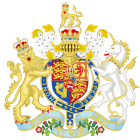Coinage Act 1816 facts for kids
| Act of Parliament | |

|
|
| Long title | An Act to provide for a New Silver Coinage, and to regulate the Currency of the Gold and Silver Coin of this Realm. |
|---|---|
| Citation | 56 Geo. 3. c. 68 |
| Territorial extent | United Kingdom of Great Britain and Ireland |
Quick facts for kids Dates |
|
| Royal assent | 22 June 1816 |
| Other legislation | |
| Repealed by | Coinage Act 1870 |
|
Status: Repealed
|
|
| Text of statute as originally enacted | |
The Coinage Act 1816 (56 Geo. 3. c. 68), also known as the Coin Act 1816 or Liverpool's Act, defined the value of the pound sterling relative to gold. One troy pound of standard (22-carat) gold was defined as equivalent to £46 14s 6d., i.e. 44½ guineas, the guinea having been fixed in December 1717 at £1 1s exactly. According to its preamble, the purposes of the Act were to:
- prohibit the use of silver coins (which would now be of reduced weight, 66 shillings rather than 62 shillings per troy pound), for transactions larger than 40s
- establish a single gold standard for transactions of all sizes.
See also

All content from Kiddle encyclopedia articles (including the article images and facts) can be freely used under Attribution-ShareAlike license, unless stated otherwise. Cite this article:
Coinage Act 1816 Facts for Kids. Kiddle Encyclopedia.
